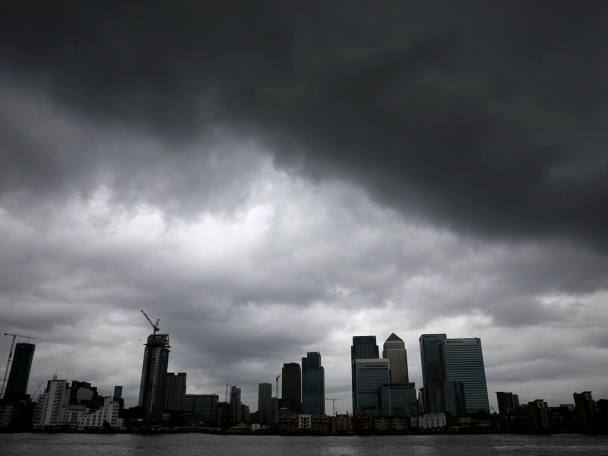Is the banking system fixed? Two recent developments suggest not. One is the complaint that banks haven’t passed on the recent rate rise to savers – which suggests that the industry isn’t yet so competitive as to give customers good deals. The other is that bank share prices have fallen in response to Turkey’s financial crisis: the sector is down almost 9 per cent from its May peak while the All-Share index has fallen only 1.5 per cent. This implies that UK banks’ exposures to global risks – albeit indirectly via loans to other banks which have lent to Turkey – are still significant.
Of course, there have been improvements since the 2008 crisis. Banks are no longer so reliant upon interbank markets. As the Bank of England’s Jon Cunliffe has described, the Bank now has better ways of coping with failed banks. And banks are better capitalised; the Bank of England estimates that they have seven times as much capital as they had in 2008 and that their capital now accounts for 17 per cent of their risk-weighted assets.
Partly as a result of this better capitalisation, the implicit subsidy to banks (their ability to borrow at low rates because of the belief the government will bail them out if needed) has fallen. The Bank estimates it is now around £5bn compared to £45bn in 2010.
Some, however, question just how safe the banks are. That capital ratio of 17 per cent is well below the 20-30 per cent which Anat Admati and Martin Hellwig called for in their book, The Bankers’ New Clothes. And Durham University’s Kevin Dowd says measures of risk-weighed assets are “make-believe” and estimates that leverage ratios (ratios of capital to assets at risk) are still “very low”.
Others think the implicit subsidy is still too high: does your industry have one? In his recent book, Adam Smith: What He Thought and Why It Matters, the Conservative MP Jesse Norman accuses banks of “turbo charged” rent extraction and says: “The banking sector may be generating little or no net real economic value.”
One sign of this is that it does a poor job of financing industry. Bank of England data show that the stock of bank lending to small and medium-sized manufacturers is a mere £10.2bn. This means that for every pound banks have lent to small manufacturers, they have lent £135 to households to buy property.
This discrepancy might get worse in future. As Jonathan Haskel (now a member of the Monetary Policy Committee) and Stian Westlake point out in their book Capitalism without Capital, intangible assets such as goodwill or ideas are becoming increasingly important. These, however, cannot be used as collateral in the way that buildings and machines can, and so banks are loath to lend against them. This helps explain why non-financial companies’ cash holdings have risen so much recently – from £241.1bn at the start of 2010 to £408.4bn now; a lack of collateral is forcing more firms to become self-financing. Which of course means banks are not financing innovation.
There’s another measure of banks’ failure – the big gap between deposit and lending rates. Bank of |England data show that the average rate banks pay on sight deposits is now just 0.4 per cent whilst the average floating-rate mortgage rate is 3.1 per cent. That’s a gap of 2.7 percentage points. And this has been edging up since 2010 (having fallen sharply in 2008-09). This tells us that competition isn’t strong enough to drive down margins and give customers better deals.
In fact, this is a longstanding problem. Thomas Phillippon at New York University and Guillaume Bazot at the Paris School of Economics have shown that the cost to customers of financial intermediation (gaps between borrowing and lending rates) haven’t changed for decades. Whereas technical progress in many other businesses has led to customers getting better prices or products, this is much less evident in finance.
On top of all this, there are three other problems with the industry that haven’t gone away:
- Lousy innovation. In theory there are countless financial products that could protect us from risks as Yale University’s Robert Shiller has shown, such as social care insurance, GDP-linked securities, house price futures or ways of insuring against fluctuations in future occupational incomes. Such useful products barely exist while banks have actively pushed dangerous ones such as payment protection insurance or credit derivatives.
- Agency failure. Shareholders lack the ability or incentive to monitor banks properly. One reason why financial regulation is so complicated and so important is that the job of ensuring banks remain solvent cannot be entrusted to shareholders.
- Finance is too big. IMF researchers have shown that larger financial sectors are associated with slower future growth in GDP. One reason for this might be that agency failures and the implicit subsidy combine to inflate banks’ salaries, thereby diverting talented and energetic people away from occupations in which they might be more useful.
Despite being in better shape than in 2008 the banking system is not therefore fixed. Which poses the question: what would a healthy banking system look like? It wouldn’t be one in which banks never failed. Failure is a necessary part of competition and technical change: Joseph Schumpeter called it creative destruction for a good reason. Instead, a well-functioning financial system would be one in which the failure of a bank is as inconsequential to the wider economy as, say, the failure of Carillion or Toys R Us was. We are not in such a position, and we never have been. Which tells us that banking is a most peculiar industry.










